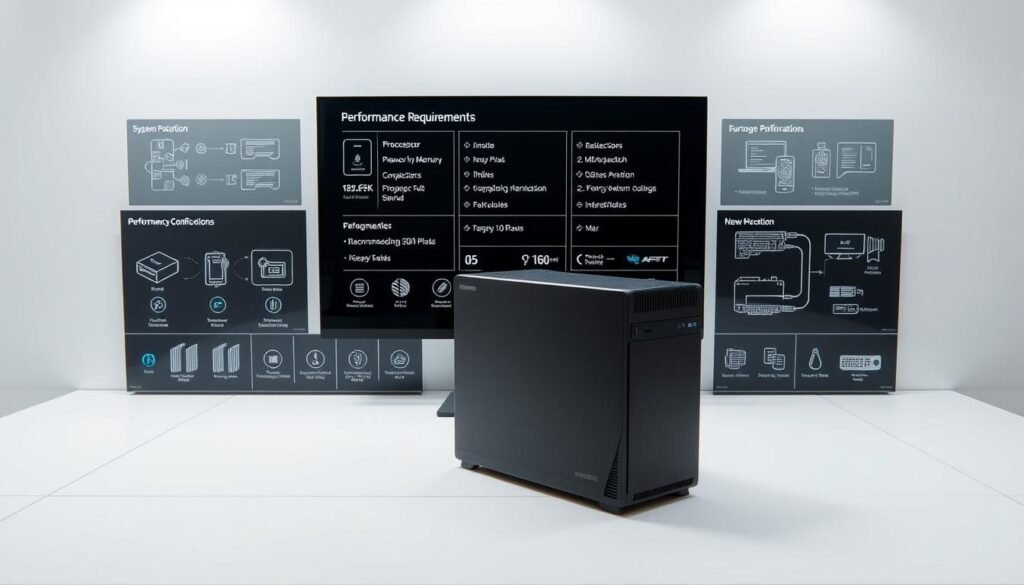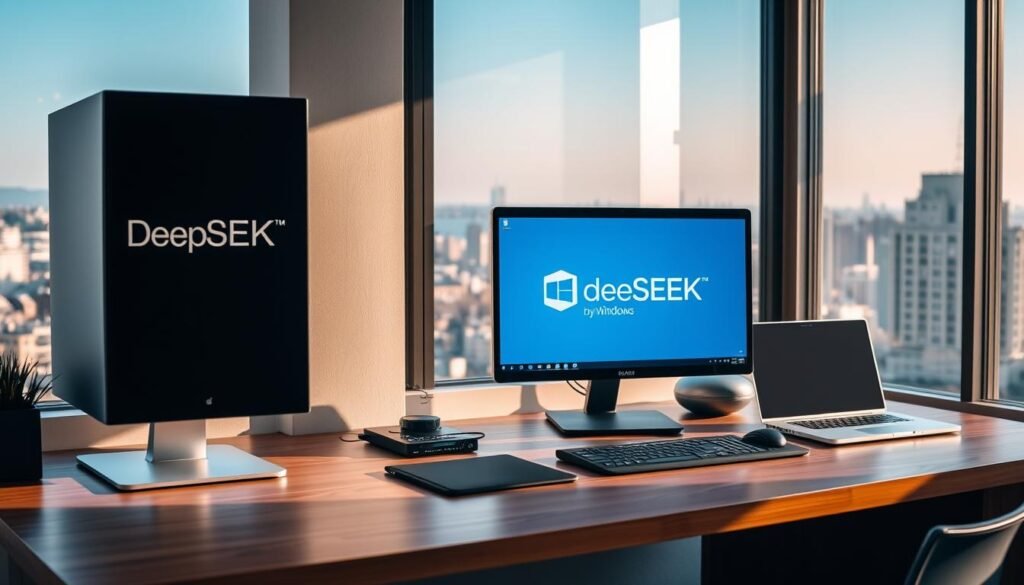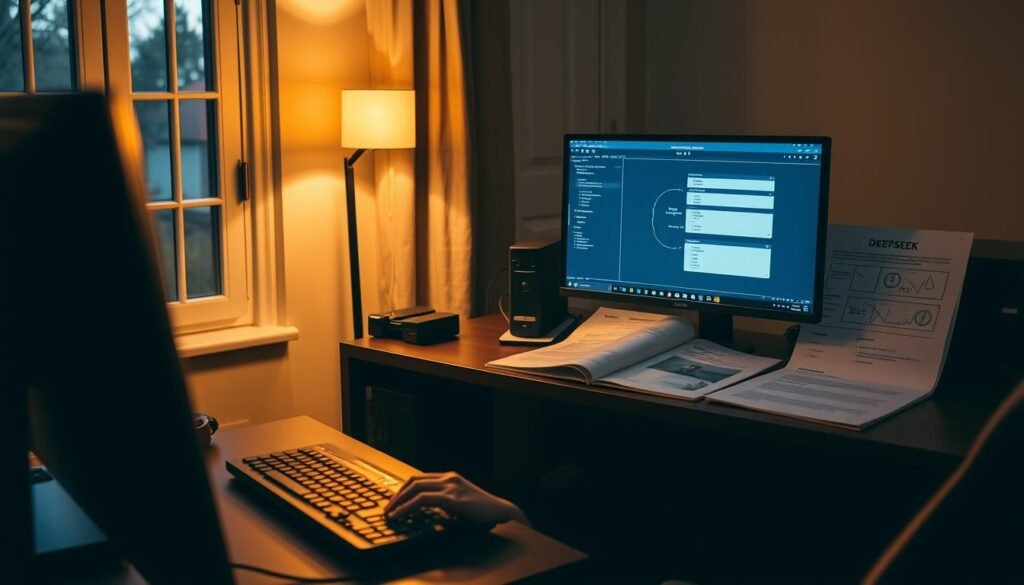About 70% of users like web interfaces better than command-line tools for local large language models. This shows the need for an easy guide on how to run DeepSEEK on Windows. We’ll explore DeepSEEK’s benefits, like 30% faster inference with hardware help. This article will guide you through DeepSEEK installation, covering system needs, installation ways, and fixing tips.
We aim to make setting up DeepSEEK on Windows easy. This guide is for everyone, from beginners to experts. It will show you how to install and run DeepSEEK on Windows, including using the DeepSEEK installation guide.
Key Takeaways
- We will cover the system requirements for running DeepSEEK on Windows, including the minimum and recommended hardware specifications.
- You will learn how to download and install DeepSEEK, including the different installation methods available.
- We will provide troubleshooting tips and solutions to common issues that may arise during the installation and setup process.
- You will discover the benefits of using DeepSEEK, including its ability to provide faster inference and improved workflow efficiency.
- We will explore the different web interfaces available for interacting with DeepSEEK, including LM Studio, Oobabooga, Gradio, and Open WebUI.
- You will learn how to configure and customize your DeepSEEK setup to suit your needs and preferences.
Introduction to DeepSEEK and Its Benefits
DeepSEEK is a powerful tool that offers advanced reasoning and problem-solving capabilities. It’s perfect for many applications. When setting up DeepSEEK on Windows, users get to enjoy its unique features.
One of these features is the MoE architecture. It reduces latency and improves efficiency. This is because only the needed “expert” is activated for each task, making resource use more efficient.
Using DeepSEEK locally on Windows has many benefits. It offers enhanced security, flexibility, and control. By following the deepseek configuration steps, users can set it up smoothly and optimize its performance.
DeepSEEK is great for tackling complex tasks and projects. It’s a must-have tool for professionals and individuals alike.
DeepSEEK supports model sizes from 1.5 billion to 671 billion parameters. It’s versatile for many applications. The minimum RAM needed for smaller models is 16GB, while larger models need at least 32GB.
For smaller models, at least 50GB of free disk space is required. Larger versions need up to 1TB.
| Model | Size on Disk | VRAM Requirement |
|---|---|---|
| DeepSeek-R1-Distill-Qwen-1.5B | 1.1GB | 3.5GB |
| DeepSeek-R1-Distill-Qwen-7B | 4.7GB | 16GB |
| DeepSeek-R1-Distill-Llama-8B | 4.9GB | 18GB |
Understanding DeepSEEK’s features and benefits helps users make the most of it. This ensures optimal performance and results.
System Requirements for Running DeepSEEK
To run DeepSEEK smoothly on Windows, you need to meet certain requirements. You’ll need an NVIDIA RTX 3090 with 24GB VRAM, an 8-core processor, 32GB of RAM, and a 100GB SSD. For better performance, aim for an NVIDIA RTX 4090 with 40GB+ VRAM, a 16-core processor, 64GB+ of RAM, and a 1TB NVMe SSD.
DeepSEEK works on Windows 10/11 and needs Docker and Ollama to run. Here are the system needs for different DeepSEEK models:
- DeepSeek R1 needs a multi-GPU setup for best results, with at least 1,342 GB of VRAM.
- DeepSeek R1-Distill-Qwen-1.5B needs about 0.7 GB of VRAM and recommends an NVIDIA RTX 3060 (12GB) or better.
- DeepSeek R1-Distill-Qwen-7B needs around 3.3 GB of VRAM and suggests an NVIDIA RTX 3070 (8GB) or better.
To set up DeepSEEK locally on Windows, make sure your system meets the minimum specs. With the right hardware and by following the setup guide, running DeepSEEK on Windows can be easy and efficient.

| Model | Minimum VRAM | Recommended GPU |
|---|---|---|
| DeepSeek R1 | 1,342 GB | NVIDIA A100 80GB x16 |
| DeepSeek R1-Distill-Qwen-1.5B | 0.7 GB | NVIDIA RTX 3060 (12GB) |
| DeepSeek R1-Distill-Qwen-7B | 3.3 GB | NVIDIA RTX 3070 (8GB) |
Downloading DeepSEEK for Windows
To start setting up a deepseek local server, we first need to download DeepSEEK. This is a key step in our guide. Make sure to visit the official website for the newest version of DeepSEEK. It will have the latest features and fixes.
When we download DeepSEEK, picking a safe source is vital. We should use the official DeepSEEK site or well-known software repositories. Always check the download’s digital signature or hash value. This ensures it’s safe and hasn’t been altered during download.
- Check the official website for the latest version of DeepSEEK.
- Choose a trusted download source.
- Verify the integrity of the download.
By doing these steps, we can get a safe and effective DeepSEEK download. This is a key part of setting up our deepseek local server. It’s an important part of our guide for Windows installation.
Installing DeepSEEK on Windows
To install DeepSEEK on Windows, we must follow several steps. The deepseek installation guide outlines this process. It includes downloading files and setting up the environment. First, check if your system meets the minimum requirements if you want to how to run deepseek locally windows.
There are three ways to install DeepSEEK: using Docker, Ollama, or WebUI. Each method has its own instructions. We’ll cover the main steps for each, making it easy to install DeepSEEK on Windows.

Step-by-Step Installation Process
The process starts with downloading files and installing dependencies. For example, with Ollama, download the installer and follow the instructions. After installation, you can set up the environment and begin using DeepSEEK.
Troubleshooting Installation Issues
Users might face problems like compatibility issues or missing dependencies during installation. For help, check the deepseek installation guide or online forums. By following the troubleshooting steps, you can fix these issues and finish the installation.
After installation, you can explore DeepSEEK’s features and learn how to run deepseek locally windows. The deepseek installation guide makes it simple to start using DeepSEEK.
Setting Up DeepSEEK for Local Use
After installing DeepSEEK on Windows, we need to set it up for local use. This involves several deepseek configuration steps that will enable us to use the software effectively. The initial setup process is key to ensuring DeepSEEK runs smoothly on our local machine.
To start, we need to import data into DeepSEEK. This is done by following a few simple steps. First, we prepare our data and make sure it’s in the right format. Then, we use the import feature in DeepSEEK to upload our data. This process is easy and can be done in a few minutes.
Initial Configuration Steps
After importing our data, we can start configuring DeepSEEK for local use. We set up the software to meet our specific needs and requirements. We can customize user preferences, like setting up the interface and configuring search parameters. This ensures DeepSEEK is tailored to our needs and gives us the best results.

Customizing User Preferences
Customizing user preferences is a key part of the setting up deepseek on Windows process. It helps ensure the software meets our specific needs and gives us the best results. We can adjust settings like the interface, search parameters, and data import options. By following these deepseek configuration steps, we can make sure DeepSEEK is set up right and works best for us.
Running DeepSEEK Locally: A Quick Start Guide
Now that DeepSEEK is installed on your Windows system, let’s dive into its features. Running DeepSEEK on Windows is easy. This guide will help you get started quickly.
We’ll start with the basic commands to begin with DeepSEEK. These commands help you navigate, import data, and start your first search. The interface is designed to be simple, making it easy to use DeepSEEK’s features.
Basic Commands to Get Started
To use DeepSEEK, learn these basic commands:
- Importing data into DeepSEEK
- Configuring user preferences
- Running your first search
These commands will help you explore DeepSEEK’s features.
Exploring the User Interface
The DeepSEEK user interface is easy to use. It has a clean layout. You’ll find all the tools and features you need, making it simple to navigate and start using DeepSEEK.
Running Your First Search
With the basic commands and a good grasp of the interface, it’s time for your first search. This will show you what DeepSEEK can do. By following this guide and running DeepSEEK on Windows, you’ll unlock its full power.
Advanced Features of DeepSEEK
Let’s dive into DeepSEEK’s advanced features. We’ll look at plugins, custom search settings, and tips for better search results. This is for those who want to get the most out of DeepSEEK and make it fit their needs.
For a great deepseek local server setup, knowing how to customize is key. DeepSEEK can work with other tools and platforms. This makes it useful for many different tasks.
For a deepseek Windows installation tutorial, there’s a simple guide. You’ll need to check if it’s installed right by using the command `ollama –version. This shows you the version number.
Some cool features of DeepSEEK include:
- Using plugins to add more functionality
- Adjusting search settings for your needs
- Improving search results for faster use
By using these advanced features, you can make DeepSEEK even better. It will help you search more efficiently.
DeepSEEK is a great tool for anyone wanting to search better. It has lots of customization options and advanced features. Whether you’re experienced or new, DeepSEEK has something for you.
| Feature | Description |
|---|---|
| Plugins | Enhance functionality with custom plugins |
| Custom Search Parameters | Optimize search results with specific parameters |
| Optimization Tips | Improve performance with expert tips and tricks |
Common Issues and Solutions
Running DeepSEEK locally on Windows can be very useful for your work. But, sometimes you might face issues. Don’t worry, we’ve got you covered for any
or
problems.
If you run into trouble, check out the DeepSEEK user community. The forums and online resources are full of helpful people. They can offer tips and solutions to any problems you might have.
Our DeepSEEK experts are also ready to help. Just contact us, and we’ll work fast to solve your issues. Together, we can tackle any
or
problems quickly.
Learning DeepSEEK on Windows is a journey. But with the right support, you’ll get the hang of it soon. Let’s start this exciting journey together!
FAQ
What is DeepSEEK?
Why should I use DeepSEEK locally on Windows?
What are the system requirements for running DeepSEEK on Windows?
Where can I download the latest version of DeepSEEK for Windows?
How do I install DeepSEEK on my Windows computer?
How do I set up DeepSEEK for local use on my Windows computer?
What are the basic commands I need to know to start using DeepSEEK locally?
What advanced features are available in DeepSEEK, and how can I utilize them?
Where can I find help if I encounter any issues while running DeepSEEK locally on Windows?
Source Links
- Free AI models: Running Local LLMS with Llama 3.3, – https://joelotepawembo.medium.com/running-local-llms-with-llama-3-3-deepseek-r1-and-other-large-language-models-using-ollama-5d0dc2d09358
- System Requirements, Docker, Ollama, and WebUI Setup – AI By PY – https://aibypy.com/how-to-install-deepseek-r1-32b-on-windows-system-requirements-docker-ollama-and-webui-setup/33/
- How to Install DeepSeek-R1 | phoenixNAP KB – https://phoenixnap.com/kb/how-to-install-deepseek
- DeepSeek R1: Architecture, Training, Local Deployment, and Hardware Requirements – https://dev.to/askyt/deepseek-r1-architecture-training-local-deployment-and-hardware-requirements-411d
- The DeepSeek Series: A Technical Overview – https://martinfowler.com/articles/deepseek-papers.html
- How to Install DeepSeek-R1 32B on Windows: System Requirements, Docker, Ollama, and WebUI Setup – https://dev.to/askyt/how-to-install-deepseek-r1-32b-on-windows-system-requirements-docker-ollama-and-webui-setup-37l4
- DeepSeek R1: Architecture, Training, Local Deployment, and Hardware Requirements – https://dev.to/askyt/deepseek-r1-architecture-training-local-deployment-and-hardware-requirements-3mf8
- Testing DeepSeek-R1:1.5B — Running AI Locally – https://generativeai.pub/testing-deepseek-r1-1-5b-running-ai-locally-7f6fac67e2bb
- Mastering DeepSeek: Installing Tiny, Small, and VL2 Models with Inference and a Gradio Interface – https://nodeshift.com/blog/mastering-deepseek-installing-tiny-small-and-vl2-models-with-inference-and-a-gradio-interface
- How to Run DeepSeek R1 on your Raspberry Pi 5 – https://www.tomshardware.com/raspberry-pi/how-to-run-deepseek-r1-on-your-raspberry-pi-5
- DeepSeek AI | All You Need to Know (Quick Guide) – https://proflead.dev/posts/deepseek-ai-all-you-need-to-know-crash-course/
- Run DeepSeek-R1 on Your Laptop with Ollama – https://dev.to/shayy/run-deepseek-locally-on-your-laptop-37hl
- DeepSeek Local: How to Self-Host DeepSeek (Privacy and Control) – https://linuxblog.io/deepseek-local-self-host/
- DeepSeek AI – Install on your Windows Machine – https://muhammad-asim.com/deepseek-ai-vs-chat-gpt-install-on-windows
- Build Your Own Offline AI Chatbot: Running DeepSeek Locally with Ollama – https://shelwyncorte.medium.com/build-your-own-offline-ai-chatbot-running-deepseek-locally-with-ollama-d8921c20bb53
- How to Run DeepSeek AI Locally on Any PC for Free – MindStick – https://www.mindstick.com/blog/305214/how-to-run-deepseek-ai-locally-on-any-pc-for-free
- How to Run Deepseek R1 Locally Using Ollama ? – https://apidog.com/blog/run-deepseek-r1-locally-with-ollama/
- How to use DeepSeek V3 Coder in Windows 11? – https://www.thewindowsclub.com/how-to-use-deepseek-coder-in-windows
- GitHub – deepseek-ai/DeepSeek-Coder: DeepSeek Coder: Let the Code Write Itself – https://github.com/deepseek-ai/DeepSeek-Coder
- How to fix common Windows 11 Problems quickly – https://medium.com/@windows101tricks/how-to-fix-common-windows-11-problems-quickly-94a7d356a224
- DeepSeek-R1 | Hacker News – https://news.ycombinator.com/item?id=42768072
